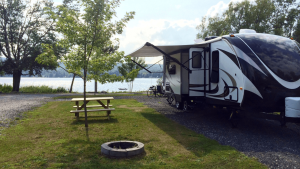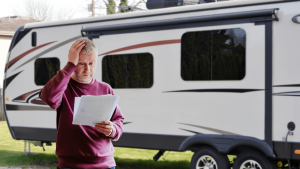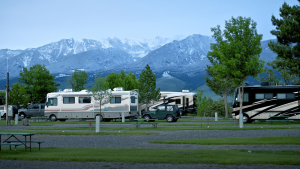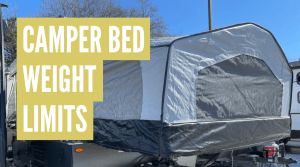RV travel can be an incredible way to see the country; in fact, it’s my favorite way, but it comes with its own set of risks.
Some of the most dangerous situations on the road happen when small oversights turn into major problems. Avoiding these mistakes by just following a few simple habits can make the difference between a safe trip and one that ends early.
1. Not Knowing Your RV’s Size and Limits
Every RV has physical limits that directly affect where and how you can travel. Height determines which bridges you can pass under, width can be an issue on narrow rural roads, and weight affects your braking distance and fuel efficiency.
Accidents from hitting low bridges are more common than most RVers realize, and repairs can cost thousands of dollars, sometimes totaling the RV. In fact, there’s a YouTube channel that posts all of the crashes at the famous “Can Opener Bridge” in Durham, North Carolina, with RVs falling victim to the bridge from time to time.
✅ Action Step: Measure your RV’s total height from the ground to the tallest point, including antennas or rooftop units. Weigh the RV when fully loaded, using a certified scale. Record these numbers on a label near the driver’s seat. Use an RV-specific GPS or navigation app that allows you to enter the height, weight, and length of your vehicle to avoid unsafe routes.
2. Skipping Tire Maintenance
Tires on RVs carry heavy loads, often sit in one place for long periods, and are exposed to varying temperatures. A tire blowout can cause loss of control, damage to the RV, and, in some cases, be fatal. Even tires with good tread can fail if they are old, underinflated, or show signs of cracking.
✅ Action Step: Check tire pressure when the tires are cold before each trip. Inspect for cracks, bulges, or uneven wear. Replace tires based on age as well as tread depth, typically within 5 to 7 years of manufacture. Consider a tire pressure monitoring system to detect problems while driving.
3. Driving Too Far in One Day
Fatigue is one of the biggest hazards for RV drivers. Handling a large, heavy vehicle requires more focus and physical effort than driving a car. After hours on the road, reaction times slow, judgment slips, and the risk of an accident increases. Long driving days can also make setting up camp stressful, especially if you arrive in the dark or bad weather.
Experienced RVers often follow the “3/300 rule”: drive no more than 300 miles or stop by 3 PM. This allows time for breaks, meals, and unexpected delays without feeling rushed. But, it really comes down to what YOU can handle.
✅ Action Step: Plan your route with realistic driving limits. Schedule breaks for fuel, meals, and rest. If a longer trip is necessary, split it into two or more days instead of pushing through in one.
4. Not Checking or Adjusting Brakes
Brakes are one of the most critical safety systems on any RV or tow setup, yet they are often overlooked until a problem becomes obvious.
Motorhomes, tow vehicles, and trailers all have different braking systems that need regular inspection and maintenance. For trailers, the brake controller settings must be adjusted for the weight being towed. If they are set too low, the trailer may not slow properly, forcing the tow vehicle to do all the work. If they are set too high, the trailer brakes can lock up, leading to skidding or loss of control.
Over time, brake components can wear down or fail, reducing stopping power. On long downhill grades, overheated brakes can fade, making it harder to stop when you need to most.
✅ Action Step: Test your brakes before every trip. For towable RVs, confirm that the brake controller is properly calibrated for your current load. Have all brakes inspected and serviced according to the manufacturer’s maintenance schedule, and be alert for signs of brake fade or reduced stopping power.
5. Ignoring Weather and Wind Conditions
Weather plays a major role in RV safety, especially for high-profile vehicles. Strong crosswinds can push an RV or trailer into another lane or cause dangerous sway. Rain, snow, and ice increase stopping distances and reduce traction, making it more difficult to maintain control. Severe weather events can also lead to flooding or road closures, forcing sudden route changes. Ignoring these risks can result in accidents, rollovers, or becoming stranded in unsafe conditions.
✅ Action Step: Check the weather forecast before leaving and monitor conditions along your route. Watch for high wind advisories, winter storm warnings, and flash flood alerts. If conditions are unsafe, adjust your plans or wait until the weather improves. Drive at slower speeds in poor conditions and allow extra space between vehicles.
6. Driving Too Fast, Especially While Towing
Speed greatly affects safety when operating an RV or towing a trailer. And I see RVers driving too fast way too often! In fact, driving too fast while towing is the #1 mistake on our 13 most common towing mistakes article.
At higher speeds, you have less time to react to obstacles or changes in traffic. Stopping distances increase, and trailer sway becomes more difficult to control. Many RV and trailer tires are only rated for speeds up to 65 miles per hour, and exceeding that can increase the risk of blowouts. High speeds also put more strain on suspension, brakes, and other components, leading to premature wear.
✅ Action Step: Follow posted speed limits and know the speed rating for your RV or trailer tires. Reduce speed in poor weather, heavy traffic, or on unfamiliar roads. Keep your speed at a level where you can maintain full control and safely stop if needed.
7. Unsafe Electrical or Propane Use
Electrical and propane systems make RV travel more comfortable, but they can also be sources of serious hazards if not handled properly. Overloaded circuits, damaged cords, or incorrect adapters can overheat and cause fires. Propane systems, if not maintained, can leak and create an explosion risk. Fires from either system can spread quickly inside an RV, where space is tight and materials can be highly flammable. Many accidents occur because a problem went unnoticed until it was too late.
✅ Action Step: Inspect electrical cords, adapters, and outlets before each trip. Replace any cord that shows damage. Store propane cylinders upright, secure them during travel, and check connections for leaks using an approved leak-detection method. Follow manufacturer guidelines for safe operation and servicing.
8. No Emergency or Safety Equipment
In the event of a fire, accident, or breakdown, having the right equipment can reduce the risk of injury and make it easier to get help. Without basic gear, even a minor roadside problem can put you and other drivers in danger. RVs are large and may be harder for passing traffic to see when stopped on the side of the road, especially at night or in poor weather. The right equipment can make you more visible and give you the tools to respond quickly.
✅ Action Step: Carry a working fire extinguisher rated for all common fire types in an easily accessible location. Keep reflective warning triangles, a flashlight, and a first aid kit on board. I also like to include basic tools for minor repairs. Reflective vests are useful for roadside situations, helping to increase visibility to passing drivers.
9. No Plan for Emergencies When Boondocking or Isolated
Boondocking and camping in remote areas can be rewarding, but they also require preparation for unexpected situations. Without nearby services or reliable cell coverage, a mechanical failure, medical emergency, or extreme weather event can leave you stranded. In these situations, access to extra supplies and a way to communicate can make a difference in how quickly help arrives.
✅ Action Step: Bring extra food and water to last longer than your planned stay. Keep a backup power source and a method of communication that works outside of cell coverage, such as satellite internet. Know your exact location, including GPS coordinates, so you can give clear directions to emergency responders. And always tell a friend or relative your travel route.
10. Improper Setup
Setup routines like hitching, leveling, and parking require full attention. When these steps are rushed or interrupted, it’s easier to overlook something that can lead to property damage or injury.
One of the most dangerous oversights during setup is failing to use wheel chocks when parking on an incline. Without them, a trailer or motorhome can roll unexpectedly, especially if the parking brake fails or isn’t fully engaged. Rollaway accidents have caused serious injuries and even fatalities.
✅ Action Step: Use our printable Setup & Teardown checklists for all setup and breakdown tasks. Avoid multitasking during these procedures and take the time to double-check your work before moving on.







Write a comment